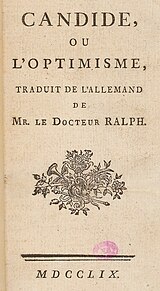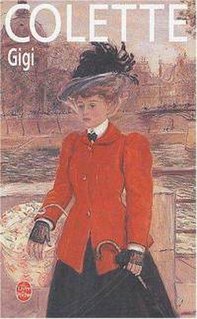 W
WL'Abbé C (1950) was Georges Bataille's first published novella. It is a work of dark eroticism, centred on the relationship between two twentieth century brothers in a small French village, one of whom is a Catholic parish priest, while the other is a libertine. It explores issues of split subjectivity and existentialist bad faith.
 W
WAtala, ou Les Amours de deux sauvages dans le désert is an early novella by François-René de Chateaubriand, first published on 12 germinal IX. The work, inspired by his travels in North America, had an immense impact on early Romanticism, and went through five editions in its first year. It was adapted frequently for stage, and translated into many languages.
 W
WLe Bal is the title of collection of 2 novellas written by Irène Némirovsky. Published in France in 1930, it has been recently re-issued, due to the increasing interest in and popularity of the author's work, following the discovery and publication of Suite Française.
 W
WBlue of Noon is an erotic novella by Georges Bataille. Although Bataille completed the work in 1935, it was not published until Jean-Jacques Pauvert did so in 1957. Urizen Books published Harry Mathews' English-language translation in 1978. The book deals with necrophilia.
 W
WCandide, ou l'Optimisme is a French satire first published in 1759 by Voltaire, a philosopher of the Age of Enlightenment. The novella has been widely translated, with English versions titled Candide: or, All for the Best (1759); Candide: or, The Optimist (1762); and Candide: Optimism (1947). It begins with a young man, Candide, who is living a sheltered life in an Edenic paradise and being indoctrinated with Leibnizian optimism by his mentor, Professor Pangloss. The work describes the abrupt cessation of this lifestyle, followed by Candide's slow and painful disillusionment as he witnesses and experiences great hardships in the world. Voltaire concludes Candide with, if not rejecting Leibnizian optimism outright, advocating a deeply practical precept, "we must cultivate our garden", in lieu of the Leibnizian mantra of Pangloss, "all is for the best" in the "best of all possible worlds".
 W
WCarmen is a novella by Prosper Mérimée, written and first published in 1845. It has been adapted into a number of dramatic works, including the famous opera of the same name by Georges Bizet.
 W
WFantômes dans la rue is the title of a novella written in French by French Nobel laureate writer J. M. G. Le Clézio. His daughter Amy Le Clézio suggested the storyline to this novella. It was first published in the French language magazine Elle, n° 2845 dated 10 July 2000.
 W
WGigi is a 1944 novella by French writer Colette. The plot focuses on a young Parisian girl being groomed for a career as a courtesan and her relationship with the wealthy cultured man named Gaston who falls in love with her and eventually marries her.
 W
WLa Grande Vie suivi de Peuple du ciel is the title of two novellasLa Grande Vie La Grande Vie has translated into English by C. Dickson as the Great Life. Peuple du ciel Peuple du ciel has not yet been translated into English, but could be given a title such as the Cloud people. La Grande Vie suivi de Peuple du ciel were written in Frenchby French Nobel laureate J. M. G. Le Clézio and published in one book.
 W
WHasard suivi de Angoli Mala is the title given to a book with two novellas, written in French by French Nobel laureate writer J. M. G. Le Clézio.
 W
WL'Ingénu, sometimes subtitled The Sincere Huron in English, is a satirical novella by the French philosopher Voltaire, published in 1767.
 W
WIsabelle is a novella by André Gide, published in 1911.
 W
WLe Jour où Beaumont fit connaissance avec sa douleur is a novella written in French by French Nobel laureate writer J. M. G. Le Clézio. It is one of the first published texts he wrote. This novella was published in book form after the famous Le Procès-Verbal, his first novel which won the Renaudot Prize in 1963. This novella was also included in a collection of short stories entitled La fièvre, .
 W
WJustine, or The Misfortunes of Virtue is a 1791 novel by Donatien Alphonse François de Sade, better known as the Marquis de Sade. Justine is set just before the French Revolution in France and tells the story of a young girl who goes under the name of Thérèse. Her story is recounted to Madame de Lorsagne while defending herself for her crimes, en route to punishment and death. She explains the series of misfortunes that led to her present situation.
 W
WLanzarote is a novella by the French author Michel Houellebecq, published in France in 2000 from a draft written at an unspecified earlier time.
 W
WThe Little Prince is a novella by French aristocrat, writer, and aviator Antoine de Saint-Exupéry. It was first published in English and French in the US by Reynal & Hitchcock in April 1943, and posthumously in France following the liberation of France as Saint-Exupéry's works had been banned by the Vichy Regime. The story follows a young prince who visits various planets in space, including Earth, and addresses themes of loneliness, friendship, love, and loss. Despite its style as a children's book, The Little Prince makes observations about life and human nature.
 W
WLobster is a French novella by Guillaume Lecasble. It was published in Paris by Les Éditions du Seuil in 2003, and has been translated into English and Spanish.
 W
WModerato Cantabile is a novel by Marguerite Duras. It was very popular, selling half a million copies, and was the initial source of Duras' fame.
 W
WMusic of a Life is a 2001 novella by the French writer Andreï Makine. A tale of Soviet oppression, it tells the story of a talented Russian piano player who has to abandon his career right before his first concert, flees to the countryside and adopts the identity of a dead soldier.
 W
WRené is a short novella by François-René de Chateaubriand, which first appeared in 1802. The work had an immense impact on early Romanticism, comparable to that of Goethe's The Sorrows of Young Werther. Like the German novel, it deals with a sensitive and passionate young man who finds himself at odds with contemporary society. René was first published as part of Chateaubriand's Génie du christianisme along with another novella; Atala, although it was in fact an excerpt from a long prose epic the author had composed between 1793 and 1799 called Les Natchez, which would not be made public until 1826. René enjoyed such immediate popularity that it was republished separately in 1805 along with Atala.
 W
WRobert Helmont is a novella by French author Alphonse Daudet. It is partly based on Daudet's actual experiences during the Franco-Prussian War of 1870-71, as described in the Preface. The book was originally published by Dentu in the 1873 Musel Universel but received little notice. It was re-published in 1891 with illustrations by "Picard and Montégut". The forest Sénart is the same described in his novel Jack and contains some of the same characters.
 W
WLe Rosier de Madame Husson is a novella by Guy de Maupassant, published in 1887. The hero is a young virtuous boy, the equivalent of a Rose Queen.
 W
WStory of the Eye is a 1928 novella written by Georges Bataille, as a psychoanalytical task, that details the increasingly bizarre sexual perversions of a pair of teenage lovers. It is narrated by the young man looking back on his exploits.
 W
WLa Symphonie pastorale is a French novella written by André Gide first published in October and November of 1919 in La Nouvelle Revue Française N°73 and N°74.
 W
WVanina Vanini is a short story published in 1829 by Stendhal (1783–1842), the nom de plume of Marie-Henri Beyle. Set in 1820s during the early Risorgimento, when Italy was under Austrian control, it concerns the love affair of a young Roman princess and a revolutionary carbonaro.
 W
WVilla Aurore is a novel written in French by French Nobel laureate J. M. G. Le Clézio.
 W
WZadig; or, The Book of Fate is a novella and work of philosophical fiction by the Enlightenment writer Voltaire. It tells the story of Zadig, a philosopher in ancient Babylonia. The author does not attempt any historical accuracy, and some of the problems Zadig faces are thinly disguised references to social and political problems of Voltaire's own day.